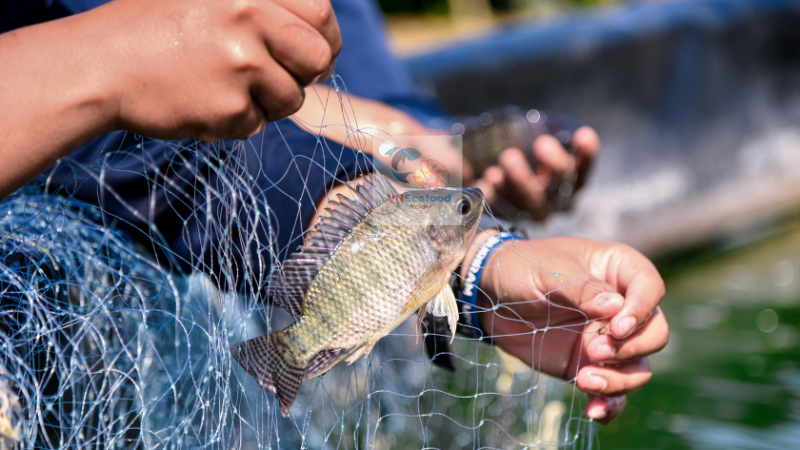Knowing how to distinguish premium frozen tilapia fillets quality from subpar products can make all the difference between satisfied customers and costly returns. At VNSeafoodInsider, we’ve seen countless importers struggle with quality assessment, often learning costly lessons through trial and error. This comprehensive guide aims to equip you with the knowledge and practical tools needed to consistently identify top-quality frozen tilapia fillets, ensuring your business thrives in this demanding market.

Outline
ToggleWhy Frozen Tilapia Fillet Quality Matters for Your Business
Before diving into the specifics of quality assessment, let’s understand why the quality of frozen tilapia fillets is paramount. High-quality frozen tilapia translates directly to better customer satisfaction, fewer returns, premium pricing opportunities, and ultimately, a stronger reputation in the marketplace.
When you import superior tilapia fillets, you’re not just buying fish – you’re investing in your brand’s reputation. One shipment of poor-quality tilapia can damage relationships with clients that took years to build. We’ve witnessed importers lose significant accounts because they failed to properly assess frozen tilapia fillet quality before distributing to their customers.
Key Visual Indicators of Premium Frozen Tilapia Fillets
Color and Appearance
The visual assessment of frozen tilapia fillets begins with their color. Premium quality fillets display a consistent, translucent white to pinkish-white hue. When thawed, high-quality tilapia maintains this pleasing appearance rather than turning dull or yellowed.
“I remember visiting an importer who couldn’t understand why his sales were declining,” shares our quality expert. “When we examined his inventory, the tilapia fillets had obvious yellow discoloration – a clear indicator of oxidation and poor freezing practices. His customers could see what he couldn’t.”
Look for these positive visual indicators:
- Uniform color throughout the fillet
- Absence of yellow or brown discoloration
- Clean appearance without blood spots
- Natural sheen (not excessive glossiness that might indicate chemical treatment)
Size Consistency and Thickness
High-quality frozen tilapia fillets exhibit consistent sizing within their specified grade. When importing tilapia, pay close attention to the uniformity of thickness and shape across samples from the same batch.
Inconsistent sizing often indicates poor processing standards or mixing of different quality grades – both red flags for serious importers. Measure several fillets from different parts of a shipment to verify size consistency.

Texture Assessment of Frozen Tilapia Fillets
Firmness and Resilience
The texture of properly frozen tilapia fillets tells an important quality story. When slightly thawed, premium fillets should feel firm and resilient to touch, not mushy or spongy. Gently press the fillet with your finger – it should bounce back rather than remain indented.
Poor freezing methods or multiple freeze-thaw cycles will destroy the natural texture of tilapia, resulting in soft, waterlogged fillets that fall apart during cooking. This deterioration in texture is directly related to cell damage during improper freezing.
Moisture Content Evaluation
Excessive moisture in packaged tilapia fillets is a significant quality concern. When thawing samples, observe how much liquid is released. High-quality frozen tilapia fillets will release minimal water when thawed properly.
One technique VNSeafoodInsider recommends to importers is the paper towel test:
- Place a thawed fillet on a dry paper towel for 2-3 minutes
- Lift the fillet and examine the towel
- Excessive moisture transfer indicates water-retention issues or glazing manipulation
Remember, while some moisture release is normal, excessive drip loss suggests poor handling, processing, or freezing techniques that have damaged the fish’s cellular structure.
Sensory Evaluation: The Ultimate Quality Test
Aroma Assessment
Even when frozen, tilapia should never have a strong, unpleasant odor. When thawed, high-quality tilapia fillets should have a mild, clean scent reminiscent of fresh water. Any strong “fishy” smell, ammonia-like odor, or chemical scent indicates quality problems.
“The nose knows,” as we like to say at VNSeafoodInsider. Your sense of smell is a powerful quality control tool that can detect problems even sophisticated equipment might miss.
Taste Profile of Quality Tilapia
If possible, conduct taste tests with properly cooked samples from each major shipment. Premium tilapia has a mild, slightly sweet flavor with a clean finish. Poor quality fillets often taste muddy, excessively fishy, or have off-flavors that persist after cooking.

Document taste profiles systematically using a simple scoring system across categories like:
- Clean flavor (1-5)
- Texture when cooked (1-5)
- Aftertaste (1-5)
- Overall eating experience (1-5)
This sensory data becomes invaluable when comparing suppliers or communicating quality standards to your team.
See other article: Top five tilapia producers in vietnam
Processing and Packaging Quality Indicators
Glazing Assessment
Proper glazing protects frozen tilapia fillets from freezer burn and dehydration. However, unscrupulous processors sometimes use excessive glazing to increase weight. To assess glazing quality:
- Weigh a frozen sample
- Carefully thaw and dry the fillet
- Reweigh and calculate the percentage difference
- Industry standards typically accept 5-10% glazing
Excessive glazing not only means you’re paying for water instead of fish but can also indicate attempts to mask lower quality products.
Packaging Integrity
Quality packaging protects frozen tilapia fillets during storage and transportation. Inspect packaging for:
- Intact vacuum sealing without air pockets
- Absence of ice crystals inside packaging (indicating temperature fluctuations)
- Clear, legible labeling with production dates and traceability information
- Proper protective outer packaging to prevent damage during transport
“We once consulted for an importer facing consistent quality issues,” our packaging specialist recalls. “The problem wasn’t with the fish itself but with compromised vacuum packaging that allowed air exposure during long-distance shipping. Simply changing packaging specifications solved their quality problems.”
Scientific Quality Measures for Serious Importers
For importers handling significant volumes, implementing more technical quality assessment methods provides additional protection against substandard products.

Chemical Testing Parameters
Consider implementing testing for:
- Histamine levels (indicates proper cold chain maintenance)
- Total Volatile Basic Nitrogen (TVB-N) levels (measures freshness)
- Peroxide Value (indicates oxidation level)
- Moisture content percentage (identifies water addition)
Many third-party laboratories offer these services at reasonable costs, providing objective data that can help resolve disputes with suppliers.
Microbiological Safety Standards
Beyond quality concerns, safety is paramount. Establish testing protocols for:
- Total plate count
- E. coli and coliforms
- Salmonella
- Listeria monocytogenes
Documenting your adherence to stringent safety standards protects both your customers and your business reputation.
See other article: How US Reciprocal Tariffs impact Vietnam Seafood Exporters
Establishing a Systematic Quality Assessment Protocol
Based on our experience working with successful tilapia importers, we recommend implementing a structured quality assessment system:
- Visual inspection – Examine color, appearance, and packaging
- Physical assessment – Check texture, firmness, and moisture content
- Sensory evaluation – Assess smell and taste (when possible)
- Documentation – Record findings using standardized forms
- Supplier feedback – Communicate issues promptly with specific details
Consistency is key – apply the same standards to every shipment, regardless of supplier relationships or market pressures.
Common Quality Issues with Frozen Tilapia Fillets and Their Causes
Understanding the root causes of quality problems helps you address issues at their source:
|
Quality Issue |
Possible Causes |
How to Address |
|
Yellow discoloration |
Oxidation, poor freezing |
Verify freezing processes, check cold chain maintenance |
|
Excessive moisture |
Over-glazing, freezer burn |
Specify acceptable glazing percentages in contracts |
|
Mushy texture |
Multiple freeze-thaw cycles |
Investigate transportation conditions, improve cold chain |
|
Strong odor |
Spoilage before freezing |
Require suppliers to demonstrate freshness before processing |
|
Size inconsistency |
Poor grading practices |
Specify exact sizing requirements with acceptable deviations |
Choosing Reliable Suppliers for Premium Frozen Tilapia Fillets
The ultimate quality assurance strategy begins with selecting suppliers who consistently deliver premium products. When evaluating potential tilapia suppliers, consider:
- Certification status (BAP, ASC, HACCP compliance)
- Processing facility conditions (request virtual tours if in-person visits aren’t possible)
- Cold chain management capabilities
- Willingness to provide consistent quality documentation
- Transparency about farming and processing methods
“The most successful importers we work with at VNSeafoodInsider treat suppliers as partners in quality,” notes our supply chain expert. “They invest time in understanding each supplier’s operations and collaborate on continuous quality improvement rather than simply rejecting shipments when problems arise.”

Conclusion: Building Your Expertise in Frozen Tilapia Fillet Quality
Becoming proficient at identifying high-quality frozen tilapia fillets is a skill developed through experience and consistent application of the principles outlined in this guide. Start by implementing basic visual and textural assessments, then gradually incorporate more sophisticated quality measures as your business grows.
At VNSeafoodInsider, we believe that quality assessment should be viewed not as a cost center but as an investment that yields substantial returns through enhanced customer satisfaction and brand reputation. By systematically evaluating frozen tilapia fillet quality, you position your import business for sustainable growth in an increasingly quality-conscious marketplace.
Remember, your customers may not fully understand all the technical aspects of tilapia quality, but they definitely know the difference when they experience it on their plate. Make quality your competitive advantage by mastering the art and science of frozen tilapia fillet assessment.
Looking for personalized guidance on tilapia quality assessment or supplier recommendations? Contact VNSeafoodInsider’s consulting team for specialized support tailored to your import business needs.

Pingback: Chinese Tilapia US Tariff: Additional 125% Rate Creates Market Shift and Opportunity